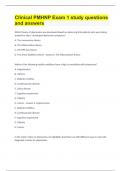-
1. Exam (elaborations) - Pmhnp ancc exam questions with 100% correct answers
-
2. Exam (elaborations) - Pmhnp ancc review questions with verified correct answers
-
3. Exam (elaborations) - Ancc certification pmhnp chapter 7 exam questions and answers (verified for accuracy)
-
4. Exam (elaborations) - Ancc pmhnp 100 questions with verified correct answers 2023 update
-
5. Exam (elaborations) - Pmhnp ancc review questions with 100% correct answers
-
6. Exam (elaborations) - Ancc review manual pmhnp 2023 update with verified correct answers
-
7. Exam (elaborations) - Ancc pmhnp lab values
-
8. Exam (elaborations) - Sample test questions with complete solutions ancc - pmhnp
-
9. Exam (elaborations) - Ancc pmhnp role and scope of practice exam questions and answers
-
10. Exam (elaborations) - Ancc agacnp certification exam questions and answers(verified for accuracy).
-
11. Exam (elaborations) - Ancc pmhnp theories exam study guide with complete verified solutions
-
12. Exam (elaborations) - Ancc pmhnp lab values 2023 update
-
13. Exam (elaborations) - Ancc pmhnp cert exam review questions and answers verified for accuracy
-
14. Exam (elaborations) - Ancc pmhnp chpt 8 questions and answers verified & updated 2023-2025
-
15. Exam (elaborations) - Ancc med-surg certification exam questions with 100% correct answers
-
16. Exam (elaborations) - Pmhnp ancc exam questions with complete solutions
-
17. Exam (elaborations) - Pmhnp ancc practice questions and answers
-
18. Exam (elaborations) - Ancc agacnp certification exam questions and answers
-
19. Exam (elaborations) - Ancc nursing certification exam questions with verified correct answers
-
20. Exam (elaborations) - Ancc pmhnp chpt 3 exam questions and answers
-
21. Exam (elaborations) - Ancc med-surg certification exam questions and answers (verified for accuracy)
-
22. Exam (elaborations) - Pmhnp ancc iq domain 5 exam questions and answers verifed for accuracy
-
23. Exam (elaborations) - Ancc pmhnp chapters 14-17 exam questions and answers
-
24. Exam (elaborations) - Ancc review manual pmhnp questions and answers
-
25. Exam (elaborations) - Med-surg. ancc certification exam questions and answers
-
26. Exam (elaborations) - Ancc certification pmhnp chapter 7 with complete verified solutions
-
27. Exam (elaborations) - Pmhnp exam prep questions and answers(verified for accuracy).
-
28. Exam (elaborations) - Pmhnp ancc questions and answers
-
29. Exam (elaborations) - Pmhnp exam reported questions images, pmhnp with verified solutions
-
30. Exam (elaborations) - Question bank for pmhnp boards 2023 fully solved(verified for accuracy)
-
31. Exam (elaborations) - Pmhnp ancc practice questions fully solved
-
32. Exam (elaborations) - Pmhnp-63 exam reported questions and answers
-
33. Exam (elaborations) - Clinical pmhnp exam 1 study questions and answers
-
34. Exam (elaborations) - Ancc practice questions domain 1 fully solved
-
35. Exam (elaborations) - Pmhnp certification exam km questions with verified correct answers
-
36. Exam (elaborations) - Pmhnp boards - scientific foundation and advance practice skills with 100% correct an...
-
37. Exam (elaborations) - Ancc pmhnp exam prep questions and answers verified for accuracy 2023 update
-
38. Exam (elaborations) - Ancc pmhnp exam questions with 100% correct answers(verified for accuracy)
-
39. Exam (elaborations) - Ancc pmhnp board exam questions and answers 2023
-
40. Exam (elaborations) - Practice questions ancc pmhnp with 100% correct answers
-
41. Exam (elaborations) - Ncc pmhnp exam chpt 4 with complete solutions
-
42. Exam (elaborations) - Ancc 25 practice questions fully solved.
-
43. Exam (elaborations) - Pmhnp study from vital boards
-
44. Exam (elaborations) - Phnp - purple book 4th edition 100 questions fully solved(verified for accuracy)
-
45. Exam (elaborations) - Psychopharm exam 1 practice questions and answers
-
Show more




